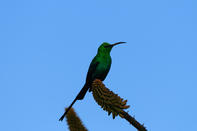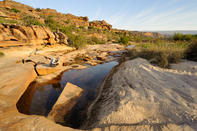Flora and Fauna
Bushmans Kloof Wilderness Reserve is home to an array of beautiful plantlife. The three main vegetation types found in the area are Fynbos, Forest and Karoo biomes.

The Cape Floral Kingdom consists of 750 indigenous fynbos species in the reserve and comprises of herby reeds, heathers, wildflowers and succulents. The indigenous Rooibos plant is also found here, which is renowned for its health benefits and great taste. The Clanwilliam Cedar tree is a protected species under the Clanwilliam Cedar Tree Conservation Project. The reserve grows tree saplings in a Cedar nursery, and now boasts with an entire grove of trees.
Flower Season (July to October) sees the wilderness area burst into a colourful array of spring wildflowers. The wildlife in the reserve includes the endangered Cape mountain zebra, as well as baboons, klipspringer, Cape fox, caracal, Cape clawless otter, aadvark and African wildcat.
The reserve has also implemented a wildlife reintroduction programme that led to species such as bontebok, red hartebeest, grey rhebok and the ostrich being introduced into the area. There is a huge diversity of birdlife in the reserve as well, with more than 150 species to be found. Bird watchers can look out for African fish eagle, sunbird, common scimitarbill and black harrier, as well as waterfowl.
Activities

Bushmans Kloof Wilderness Reserve offers visitors a bushveld oasis where they can explore the natural environment and experience outdoor adventures through a range of activities. The Bushmen tribe, mankind’s oldest nation, lived in the area around 120 000 years ago.
Their legacy is forever imprinted along the various caves of the reserve, where they stained the rock with oxide pigments, depicting their traditional way of life. The reserve protects over 130 rock art sites, some of which are around 10 000 years old. The fascinating art sites have been declared a South African Natural Heritage Site and can be viewed by guests.
In 2004, the reserve opened a Heritage Centre, which is home to a collection of Bushman artefacts such as dancing sticks, hunting kits, musical instruments and digging sticks. As the reserve is predator and malaria-free, hiking and mountain biking trails are open for guests to explore the beautiful surroundings at their own pace. The routes range from easy to more strenuous (for those who want to test their endurance skills).
The Mountain Trail is an easy, 1-2 hour hike; the Riverine Trail is more adventurous and follows a route over steep ravines. The Crystal Pools Trail is for seasoned hikers, where you can swim in the water pools and cascade down a nearby waterfall. Guides can accompany visitors on request. As tributaries of the Olifants River flows through the reserve, canoeing and swimming are popular activities. Fly-fishing in the reserve’s dams are also on offer, and the endemic Clanwilliam yellowfish can be fished on a strict catch-and-release basis.
 Bushmans Kloof Wilderness Reserve is a National Heritage Site. It borders South Africa's largest proclaimed wilderness area originally named...
Bushmans Kloof Wilderness Reserve is a National Heritage Site. It borders South Africa's largest proclaimed wilderness area originally named... The Cederberg is named for the forests of Clanwilliam cedar trees that were all but exterminated two centuries ago for their fine timber. To...
The Cederberg is named for the forests of Clanwilliam cedar trees that were all but exterminated two centuries ago for their fine timber. To...